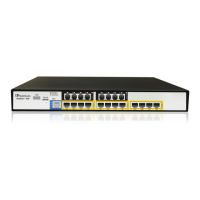The steps for configuring alternative Tel-to-IP routing based on SIP response codes are
summarized below.
To configure alternative Tel-to-IP routing based on SIP response codes:
1. Enable alternative routing based on SIP responses, by setting the 'Redundant Routing
Mode' parameter to one of the following:
• Routing Table for using the Outbound IP Routing table for alternative routing.
• Proxy for using the Proxy Set redundancy feature for alternative routing.
2. If you are using the Outbound IP Routing table, configure alternative routing rules with
identical call matching characteristics, but with different IP destinations. If you are
using the Proxy Set, configure redundant proxies.
3. Define SIP response codes (call failure reasons) that invoke alternative Tel-to-IP
routing:
a. Open the Reasons for Alternative Routing page (Configuration tab > VoIP menu
> GW and IP to IP submenu > Routing submenu > Alternative Routing
Reasons).
Figure 26-6: Tel to IP Reasons - Reasons for Alternative Routing Page
b. Under the 'Tel to IP Reasons' group, select up to five different SIP response
codes (call failure reasons) that invoke alternative Tel-to-IP routing.
c. Click Submit.
26.5.3 PSTN Fallback
The PSTN Fallback feature enables the device to re-route a Tel-to-IP call to the legacy
PSTN using one of its trunks if the IP destination is unavailable. For example, if poor voice
quality is detected over the IP network, the device attempts to re-route the call to the
PSTN.
The steps for configuring alternative Tel-to-IP routing to the legacy PSTN are summarized
below.
To configure alternative Tel-to-IP routing to the legacy PSTN:
1. Configure an alternative routing rule in the Outbound IP Routing table with the same
call matching characteristics (e.g., phone number destination), but where the
destination is the IP address of the device itself.
2. Configure an IP-to-Tel routing rule in the Inbound IP Routing table to route calls
received from the device (i.e., its IP address) to a specific Trunk Group connected to
the PSTN. This configuration is necessary as the re-routed call is now considered an
IP-to-Tel call. For configuring IP-to-Tel routing rules, see 'Configuring the Inbound IP
Routing Table' on page 336.
Note: The PSTN Fallback feature is applicable only to digital interfaces (e.g., E1 /
T1 trunks).

